new posts in all blogs
Viewing: Blog Posts Tagged with: Orangutangled, Most Recent at Top [Help]
Results 1 - 4 of 4
How to use this Page
You are viewing the most recent posts tagged with the words: Orangutangled in the JacketFlap blog reader. What is a tag? Think of a tag as a keyword or category label. Tags can both help you find posts on JacketFlap.com as well as provide an easy way for you to "remember" and classify posts for later recall. Try adding a tag yourself by clicking "Add a tag" below a post's header. Scroll down through the list of Recent Posts in the left column and click on a post title that sounds interesting. You can view all posts from a specific blog by clicking the Blog name in the right column, or you can click a 'More Posts from this Blog' link in any individual post.
b y Sudipta Bardhan-Quallen
y Sudipta Bardhan-Quallen
It’s still early in Picture Book Idea Month, and hopefully you’re all still overflowing with ideas that you can put down on paper. It does get tougher as the month continues, but bravo to you for taking up the challenge!
You’re going to come up with a lot of different kinds of ideas. You’ll think of titles, puns, and images that you see in your mind’s eye. You’ll imagine complicated scenarios and Holy Grails. You’ll draft punchlines and scenes that tug at the heart. All of these varied things can eventually grow into a beautiful, successful picture book.
But no matter what you start with, character is almost always the key to crafting a book that will be published.
POPPYCOCK! you say. CODSWALLOP! BUNK! After all, there are so many other things we hear about that make editors want to publish a manuscript. Compelling plots. Flawless writing. Powerful marketing hooks. And those are all vital things! Your plot has to be gripping and unique. The writing must be impeccable and beautiful to read. There has to be hooks to help the book sell.
But all of those things pale in comparison to the character.
It is the character that the reader will fall in love with. It is the character who he will root for. It is the character he will draw on his fan mail to you. It is the character who will live on in his imagination for week, months, years to come.
It is the character you have to get right.
Let’s talk about some ways to do that.
Character is Like the Salt

Every once in a while when I’m cooking dinner, I totally forget to add salt. The meal I end up with is nothing short of disgusting and inedible. Salvageable, yes—as long as I add some salt to it. But without that one ingredient, dinner is nothing like what it is supposed to be.
Character is the salt in your picture book idea.
Some meals use a lot of salt. Others, just a sprinkling. But salt is essential. The same holds true for character.
Even in a high concept idea (which is becoming increasingly popular in picture books), you still need that sprinkling of salt, errrr, character. Here’s an example: I have a book coming out soon called RUTABAGA BOO (which will be illustrated by the uber-talented Bonnie Adamson). The entire book is about the unbreakable bond between a son and his mother. Whenever the son needs his mother, he says, “Rutabaga!” To show that she is there, she answers, “Boo!”
On the surface, it may not seem like there is a lot of character in this idea. (I mean, how much character development can you show in 22 words?) But while the heart of this story is the mother/son bond, what draws the reader in is what you learn about the characters—and how much those details endear the characters to the reader. Every spread tells you something more about the characters—what they like to do, what scares them, what makes them feel better. The characters in this case may just be a sprinkling of salt—but without them, the story doesn’t mean nearly as much to the reader.
Think Wedding Cake, Not Cupcake

Let’s belabor the cooking theme some more.
As you are thinking of you PiBoIdMo ideas (and you are focusing on character because you, like me, believe character is the key), make sure you incorporate layers from the beginning. Just like a wedding cake is more impressive because of its tiered layers, you want to create a character that has, well, tiers and layers. Don’t let your idea stand at “Cindy wants a new puppy.” Push it to the limit (even at the idea stage):
- Can you enhance the theme? “Cindy wants a puppy so she can join the kids who walk their dogs afterschool and make some new friends” or “Cindy wants a puppy so she isn’t so lonely”
- Can you ratchet up the conflict? “Cindy wants a puppy but her father hates dogs” or “Cindy wants a puppy – but she only wants responsibility for the top half (the bottom half – and anything that comes out of the bottom – should be her brother’s responsibility!)”
- Can you make your character a study in contradictions? “Cindy wants a new puppy—and yet, she is allergic to dog hair!” or “Cindy wants a puppy but she already has a kitten who is deathly afraid of dogs”
Every time you add a layer to the idea, you make your story inherently more interesting. And no matter where you add the layer, try to leverage into making the character more complex.
To go back to the RUTABAGA BOO example, layers were very important to make that story meaty enough to merit a hardcover picture book. It wasn’t enough to say that the son wanted to be with his mother in a whole bunch of different scenarios. When I wrote the story, I thought about all the different reasons that children want their parents. Would he look for her when he was hungry? When he was scared? How would those look different? How about when the boy was excited – how would he look for his mother then? When he was lonely? When he was tired? What kinds of scenes would show all these diverse interactions that create a relationship?
I started with the cupcake model of “sons like having their mothers nearby” and added tiers to make the story mouthwatering. In 24 words (and Bonnie’s beautiful illustrations, the reader is left with a full depiction of the mother / son bond – and meets characters that they can identify with.
Envision Your Character
After I’ve lectured you on the importance of character, I’m sure you’re all committed to brainstorming great characters every day of PiBoIdMo 2014. So now I’d like to give you a tool to help you with that.
When I teach kids at author visits about developing characters, I give them a graphic organizer to help them get their thoughts down on paper. As it turns out, that organizer works really well for picture book authors, too. (I know. I use it!) So here you go, PiBo-ers! Your own Character Graphic Organizer to help you develop your ideas…
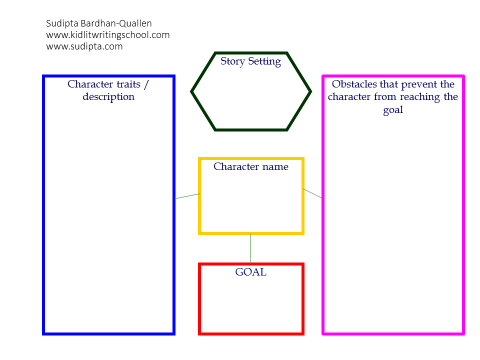
Click for full-sized, printable version.

Sudipta is an award-winning author of over 40 books and the co-founder of both Kidlit Writing School and Kidlit Summer School. Her books include DUCK DUCK MOOSE, TYRANNOSAURUS WRECKS, ORANGUTANGLED, and over thirty more books that have been acclaimed by the Junior Library Guild, the California Reader’s Collection, the Bank Street Books Reading Committe, the Amelia Bloomer list, and many more. Find out more about her by visiting SUDIPTA.COM or her blogs NERDYCHICKSRULE.COM and NERDYCHICKSWRITE.COM.
Facebook: https://www.facebook.com/SudiptaBardhanQuallen
Twitter: @SudiptaBQ
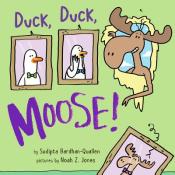



One lucky commenter will receive a free picture book course at Kidlit Writing School! Our next picture book course will be on character development in picture books. The winner can opt to take that course or any other picture book course offered in 2015.
This prize will be given away at the conclusion of PiBoIdMo. You are eligible for this prize if:
- You have registered for PiBoIdMo.
- You have commented ONCE ONLY on today’s post.
- You have completed the PiBoIdMo challenge. (You will have to sign the PiBoIdMo Pledge at the end of the event.)
Good luck, and happy brainstorming!
As a bonus, ALL PiBoIdMo participants who register for a class during PiBoIdMo can get a discount on picture book courses at Kidlit Writing School by going to the secret PiBoIdMo page: http://www.kidlitwritingschool.com/piboidmo-special-registration.html. Find the coupon code to get your discount—just make sure you register before November 30!



By:
Tara Lazar,
on 3/21/2014
Blog:
Tara Lazar
(
Login to Add to MyJacketFlap)
JacketFlap tags:
Marketing,
Picture Books,
Book Marketing,
Sudipta Bardhan-Quallen,
Duck Duck Moose,
Snoring Beauty,
Orangutangled,
Nerdy Chicks Rule,
Tyrannosaurus Wrecks,
Add a tag
 by Sudipta Bardhan-Quallen
by Sudipta Bardhan-Quallen
As an author, I look forward to my next book release the way parents look forward to the birth of their child. After all, the release date is a birthday of sorts—the day my creation is real to everyone, not just me! If you’ve ever known someone expecting twins, the excitement is even higher—though, the fear associated with the event is also heightened.
This year, I’m having the publishing equivalent of quadruplets:
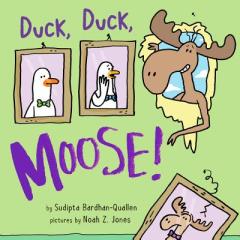


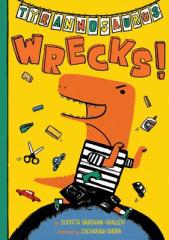
Like I said, I’ve got 99 problems, but a book ain’t one.
I get it. To have her problems, you might be thinking. After all, too many things publishing is a far better problem than too few. Or none at all. But there are problems created by my multiple birthing. Here are a few things you might not consider when praying for a year like this:
- The whirlwind of marketing becomes a tornado.
Since January, I’ve done three blog giveaways (the first was a DUCK, DUCK, MOOSE package of a book, a book, and a package of magic erasers, the second was a piece of Aaron Zenz’s original art, and the third is the autographed book we will give away here on this blog) with a fourth one coming up. I’ve done 42 Skype classroom visits—not including the 14 I have scheduled for the TYRANNOSAURUS WRECKS launch. I’ve flown to a conference in California and done a bunch of signings. I’ve revamped my website, I’ve had educator guides created, I’ve read the books so many times I have them memorized. And on the 7th day I rested…except, not really. Remember, all these marketing things are in addition to my regular job of writing, revising, preparing workshops, creating professional development. Oh, and raising all my kids.
 Too much of anything is good for nothing.
Too much of anything is good for nothing.
As much as we want to see our books in print, publishing is about more than just personal accomplishment—t’s about sales. While my ego might be excited by multiple books out at the same time, the market is another story. Have you ever heard of market saturation? Economic theory says in a given market, only so much growth can be supported. For authors, that means there are only so many new books a consumer will buy at a given time. Having too many books at once can actually reduce the probability that a fan will buy all of them, just because he may not want to buy more than a certain number of books within a short time period. This principle also extends to recognition. It’s highly unlikely that you’d have multiple books nominated for a given award in the same year. So you’ve increased your overcall competition by competing with yourself.- The “what have you done for me lately?” problem.
Let’s face it—people are basically raccoons, distracted by whatever is new and shiny. And if you have a bunch of books come out at once, chances are, that will be followed by a long gap until your next release. But a book only keeps it’s “new car smell” for a finite amount of time. When something else new and shiny comes along, you won’t be able to compete and the raccoons will move on.
So, who still wants to have lots of books published at once? And who doesn’t?
Well, let me tell you a secret—it’s not up to you.
For the most part, publishers work on their schedule. And their concerns aren’t your concerns. So books may come out slowly at regular intervals, or they might appear all at once. As authors, we don’t have much say in this.
So how do you deal with this? How can you turn all these negatives into something positive for you?
I’ve given you the problems, so let me propose some solutions:
- Find your overarching narrative.
Whenever I have a book release, I take the details of its inspiration and craft a storyline that matches to a theme. For example, every night at bedtime in my house, my kids go nuts. My son, especially, when he was younger, he refused to sleep—no naps, no bedtime, no nothing. He was absolutely convinced I was going to do something awesome. This became the backstory for CHICKS RUN WILD, and I’ve introduced the book to hundreds if not thousands of readers by telling this story. With each of your books, you should be creating a narrative as well—but when you have multiple books at once, think of an umbrella narrative that talks about all the books. For example, DUCK, DUCK, MOOSE and ORANGUTANGLED are both about having bad days (though they resolve that issue differently). When I talk about them together, I tell my audience about taking bad days, mistakes, blunders and turning them into inspiration. They’re also both about friendship, and the different ways your friends can help you get through a rough patch. When you have one narrative, that message starts to represent you as a brand instead of the individual products/books. And at the end of the day, you want fans of your brand, not just your book.
- Coordinate efforts.
When you start marketing one book, leave yourself openings to market the others. For example, when I was booking release day virtual visits for SNORING BEAUTY and I had too many requests, I offered the folks I couldn’t schedule in March a spot on the TYRANNOSAURUS WRECKS release day. So instead of having to start from scratch for the next release, I’ve got some legwork done already.
 Use this principle in your marketing materials, too. Having bookmarks printed? Think about designing something that works for all your new releases. Making postcards? Create a “New for 2014” card instead of individual designs.
Use this principle in your marketing materials, too. Having bookmarks printed? Think about designing something that works for all your new releases. Making postcards? Create a “New for 2014” card instead of individual designs.
Just breathe. As I said before, in the grand scheme of things, having too many things published at once is the better dilemma to have. Because if you’ve got to have 99 problems, at least a book ain’t one.
.
Thank you, Sudipta! This is all good to know since I will be having two books released in 2015! Yikes! TWINS! Somebody boil some water!
Do you have any questions or comments for Sudipta? Leave a comment below and you’ll be entered to win a signed copy of one of her 2014 books, YOUR CHOICE! (And a tough choice it is!)
Also be sure to visit Sudipta’s awesomely nerdy blog, Nerdy Chicks Rule.


 by Sudipta Bardhan-Quallen
by Sudipta Bardhan-Quallen
It’s Picture Book Idea Month, and I’m going to give you a math lesson.
Who remembers high school math? A long time ago, we may have learned about combinations of variables. As we go through PiBoIdMo, we need to explore different combinations to discern the optimal result.
Now, you’re thinking, well, no kidding. How does that help me?
Aren’t you lucky? I’m going to tell you.
- Step One: Finding the Variables
If you are like me, you try to come up with picture book ideas as complete entities: a character with a specific problem/resolution. But just like in your manuscript drafts, your first idea isn’t necessarily your best idea, and it definitely doesn’t need to be your last idea. If you allow yourself the freedom to separate your idea into it’s entities, you might end up with something better.
Think of it this way: if you come up with 30 characters over the next month (let’s call this variable C) with 30 definite story outcomes (this variable will be O), all you have is 30 ideas to work with. On the other hand, if you have 30 characters, each of whom has 30 story outcomes, you have many more possible ideas to develop. Mathematically, the total number of combinations is represented by this formula:
Number of combinations = C x O
In this case, you end up with 30 x 30 = 900 story ideas at the end of PiBoIdMo. That’s accomplishing a lot, isn’t it?
Basically, separating your ideas into building blocks—into variables—allows you to have useful partial ideas. How many times have you realized that there really needs to be a book about a certain topic? Or come up with an adorable character for whom you can’t think up a story?
Write these down. Add them to your C and O lists. Every once in a while, look over the lists and see if there is a combination you see that resonates with you that was different than what you originally imagined. Allowing these partial ideas to have value takes a lot of pressure off you as a writer and creator. It is very hard to have a good idea every day! But just because something isn’t the perfect idea doesn’t mean you can’t make it work for you.
- Step Two: Expanding the Combinations
A good book has a main character and a primary plot. Many books, however, have secondary characters. Some books have secondary plots.
What if some of your PiBoIdMo ideas don’t work as stories because you came up with a secondary character or a plot?
Some books even have a pair of main characters (mash-up, anyone?) What if one of your character ideas would be four times as strong if you combine it with another character?
If you combine even more variables, you make your work go even further:
Number of story ideas with 2 characters = C x (C-1) x O = 30 x 29 x 30 = 26,100 ideas!
(and a secondary plot on top of this…you get the idea…)
Again, allowing yourself to have incomplete ideas gives you the freedom to pursue many more possibilities.
Obviously, some of the combinations that come out of this process are not going to work. So you really won’t have tens of thousands of ideas to sort through. But hopefully, you’ve picked up on the fact that I’m trying to encourage you to look at your work over this month in a different way.
Whenever you can have a complete story idea, that’s fabulous. Run with it. But don’t get frustrated if inspiration comes in drips and drops instead of a flowing stream. It’s all going to be valuable in the end.
- Step Three: The Idea Wheels
I want to leave you with something fun. I’ve asked you to take your building block story variables and consider them in various combinations. You could create a spreadsheet and be very orderly about it, but what I really want you do to is have fun with it and let the random ideas percolate through your brains. So I’m inviting you to create your own Idea Wheels.
There’s a great site called WheelDecide.com, where you can create your own wheels of fortune, if you will. You can create one wheel for your character ideas and another for your story outcomes. Then, spin away until the wheels hit upon something that really works for you. It’s visual and fun, and if nothing else, there’s a winner every time!
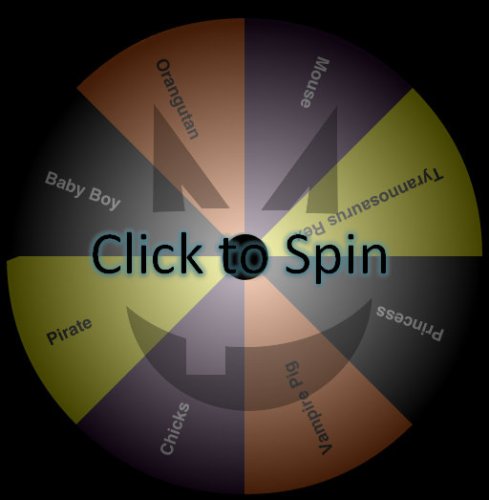
You are all just beginning your PiBoIdMo journey, and it will be a long month ahead. But I hope you stick with it—I bet you’ll come out on the other side with valuable starting points for writing. Good luck!
BONUS!
Last week, this blog hosted a double cover reveal for two of my upcoming picture books. In honor of the reveals, I held a book cover caption contest. It was not easy to pick the winner because there were so many captions that were great! But after careful consideration, on the basis that this caption works so well for BOTH covers, here is the winner:
“Is this as awkward for you as it is for me?”
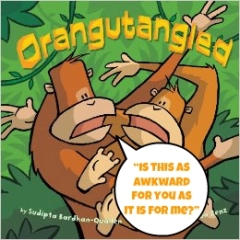
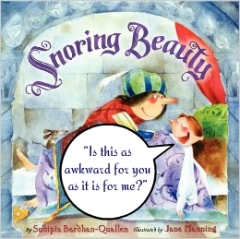
Everyone, please put your hands together for Dawn Young! Dawn wins her choice of a signed copy of ORANGUTANGLED or SNORING BEAUTY! Yay!
And one more bonus…
BONUS: If you’d like more PiBoIdMo tips, pop over to my blog at NerdyChicksRule.com for a great post about knowing what your character wants.

Sudipta Bardhan-Quallen is an award-winning children’s book author whose books include
Chicks Run Wild,
Pirate Princess,
Hampire!, and
Quackenstein Hatches a Family. She visits schools around the country to talk about the craft of writing to children of all ages. “Every book is an autobiography” is a favorite saying of hers, and a big part of her message is that everyone, grownup or child, has a story that is interesting and compelling—if you can find the right words to tell it. Sudipta lives outside Philadelphia with her children and an imaginary pony named Penny. You can learn more about her and her books on her website
www.sudipta.com or at her blog
www.NerdyChicksRule.com.


 by Sudipta Bardhan-Quallen
by Sudipta Bardhan-Quallen
Next year—2014—is going to be a hectic year for me. In January, I’ve got a new book called DUCK DUCK MOOSE releasing, illustrated by the fabulous Noah Z. Jones and published by Hyperion. But that isn’t it for the year! No, I’ve actually got THREE more picture books and a couple novels in the pipeline. It’s going to be quite a year!
I can’t share all the upcoming books with you, but I am thrilled to be able to do this:
A DOUBLE COVER REVEAL!
That’s right, folks, not just one gorgeous cover, but TWO!
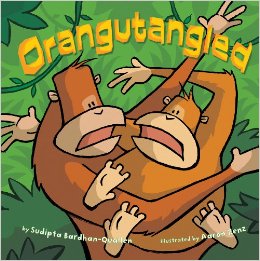
ORANGUTANGLED:
Two orangutans reach for some mangoes, fall, and land in a gooey, gummy mess. Other animals join the fray until there’s a big ball of mango-juice-covered animals rolling down a long hill to the ocean—will they be okay? Or will they make a gooey-gummy tiger treat?
Illustrated by Aaron Zenz
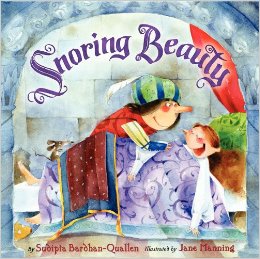
SNORING BEAUTY:
Tucked in his little bed inside the castle walls, Mouse is eager to get a good night’s sleep before his wedding tomorrow. But just as he begins to drift off, he’s awoken by a tremendous roar. SNOOOOGA-SNOOOOOM! KER-SCHUPPP! Sleeping Beauty is snoring . . . again! When the handsome Prince Max arrives, Mouse thinks he’s found the perfect scheme: He’ll convince the prince to kiss Beauty and wake her up! But when Prince Max learns that Beauty is the one making such monstrous noises, will he still want to kiss her . . . or will he run away from the noisy princess, leaving her snoring for another hundred years?
Illustrated by Jane Manning
Now, these covers are in no way alike at all. BUT…what strikes me about both of them is that they are screaming to be captioned!
What are those tangled Orangutans saying?
What is the Princess thinking as the prince gets closer? Like this:

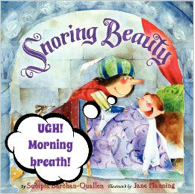
CAPTION CONTEST!
IN HONOR OF THE DOUBLE REVEAL, I’m happy to announce a new giveaway. Here’s what you have to do—just write a caption for one of these covers and put it into a comment below. We’ll keep it open for 7 days and then I will pick my favorite one. The winner will receive a signed book of his or her choice as soon as the books become available!
Good luck, and I’m looking forward to reading your captions!












 y
y 
 by
by 



 Too much of anything is good for nothing.
Too much of anything is good for nothing. Use this principle in your marketing materials, too. Having bookmarks printed? Think about designing something that works for all your new releases. Making postcards? Create a “New for 2014” card instead of individual designs.
Use this principle in your marketing materials, too. Having bookmarks printed? Think about designing something that works for all your new releases. Making postcards? Create a “New for 2014” card instead of individual designs. by
by 



 by Sudipta Bardhan-Quallen
by Sudipta Bardhan-Quallen



I love the graphic organizer. Thanks for sharing. These are great tips and suggestions.
Sudipta, your post was very helpful and I can’t wait to read “Rutabaga Boo.” I love all your books! Thanks for being an inspiration
I love the salt analogy! Thank you Sudipta for an inspiring post!
Wonderful insight about how to make compelling characters. Great graphic organizer for this process.
Great info regarding characters. Can’t wait to use the graphic organizer!
Such helpful information. As a children’s storyteller, my characters and their “tiers” come to me naturally when I’m performing, but as I try to turn these tales into books, I sometimes struggle with getting the characers to come to life on paper. Thanks for the insight.
Wedding cake not cupcake–that is such a great tip for working in layers! Thanks for a great post!
Woke up to your wonderful post! Thanks so much! Going over my ideas & building characters. Now I’m hungry for (salty) cake! :)
Great analogies! Always enjoy reading your character development lessons. You make some great points and I love that you tie it all in to food…after all, who doesn’t love cake! Thanks again for the insight!
I love character driven books. thanks on the advice on how to write one.